Digitised@SLQ: Herbert Thomas Moffitt Mallyon Papers
By JOL Admin | 15 September 2015
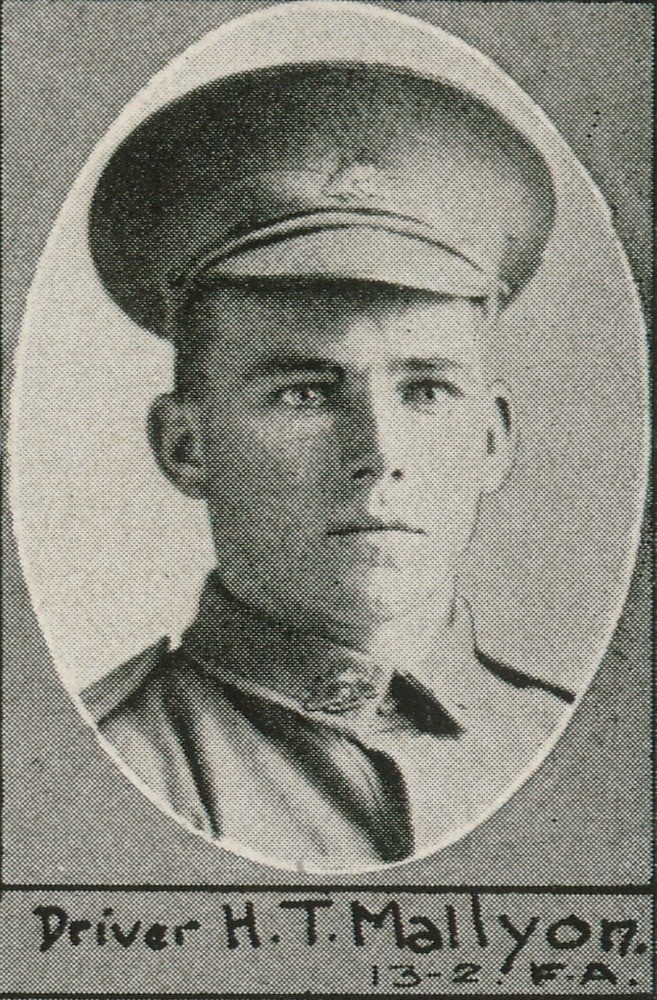
Driver H.T. Mallyon photographed in The Queenslander Pictorial supplement 1916. Image number 702692-19160325-s0026-031, John Oxley Library, State Library of Queensland.
State Library has recently digitised and transcribed the collection of Herbert Thomas Moffitt Mallyon, a young station hand from central Queensland. The collection contains two diaries, a series of postcards, a letter and a handful of photographs.
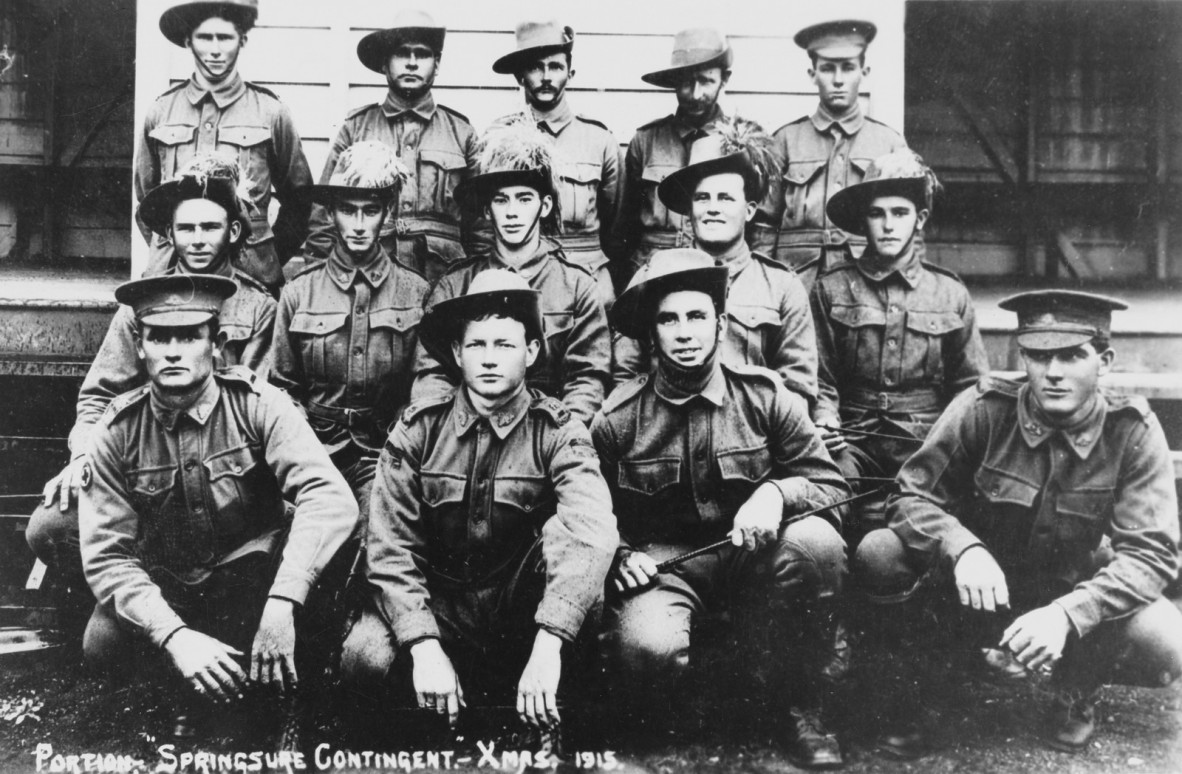
Soldiers and officers from the Springsure contingent of the Australian Imperial Force, Springsure, 1915. (Mallyon middle row, far left), Negative number 9708, John Oxley Library, State Library of Queensland.
Herbert grew up in Dalwood, Springsure, and in August 1915 left the family property and travelled to Brisbane to enlist. In January 1916 he embarked on H.M.A.T. Runic as part of the 13th Reinforcement, 2nd Light Horse Field Ambulance, but upon his arrival in Egypt Herbert was deployed to the 15th Field Ambulance as a driver. After four months in the desert he boarded the Royal George, bound for Marseilles, and by July 1916 he was working as a stretcher bearer in the trenches of Bac St Maur.
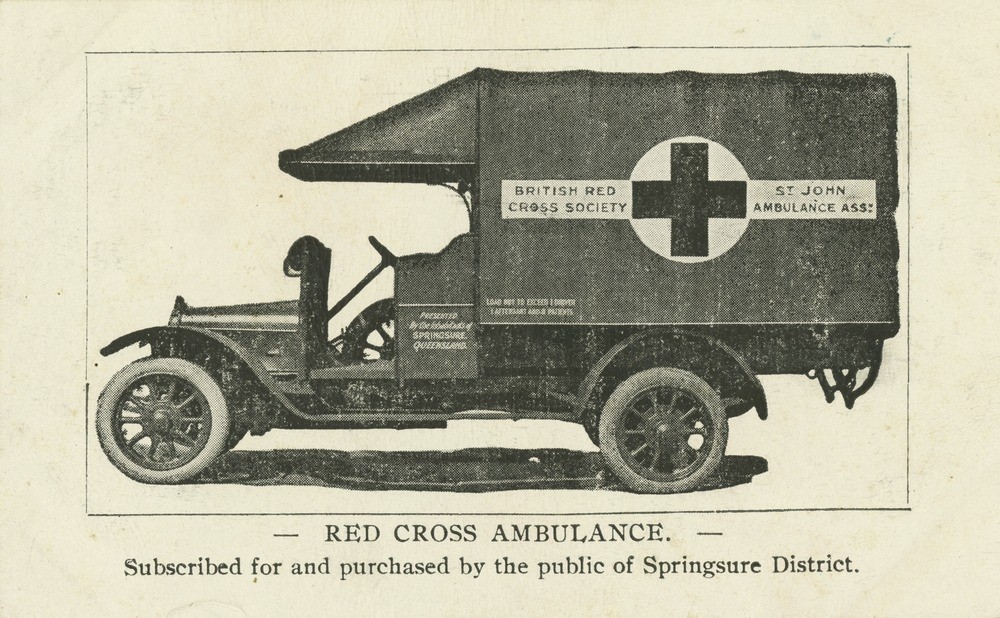
Postcard, 1916, M 767/4. Postcard featuring a the Red Cross ambulance subscribed for and purchased by the public of Springsure District. M 767 Herbert Thomas Moffitt Mallyon Papers, John Oxley Library, State Library of Queensland.
The M767 Herbert Thomas Moffitt Mallyon Papers ca. 1915 - ca. 1920 contain postcards from Herbert to his mother Mary Ellen, photographs of Herbert and his mates, and two diaries from 1916 and 1917. In his diaries, Herbert wrote about life in the trenches, and his daily activities as part of C Section, 15th Field Ambulance. Although brief, his entries conveyed the horror of their situation, as he described the noise of heavy bombardment, the harsh winter, and the challenges of carrying wounded for miles over wet and muddy ground in the rain.
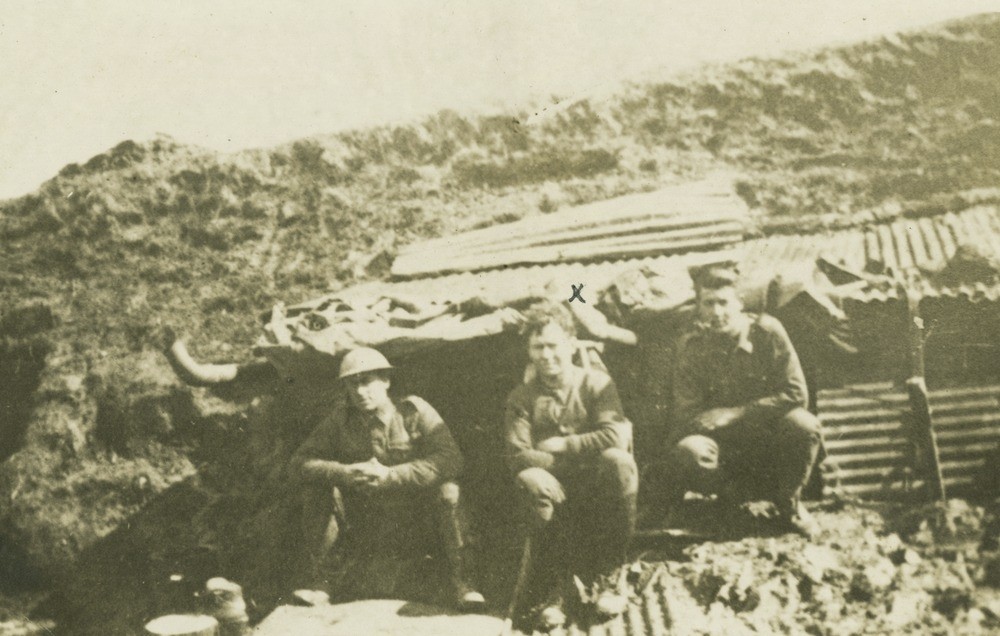
Postcard, M 767/9. Postcard showing three diggers outside a dugout. Mallyon (centre) with two comrades in a muddy dugout, France. M 767 Herbert Thomas Moffitt Mallyon Papers, John Oxley Library, State Library of Queensland.
Thursday 9 May 1917
Between Bapaume & Vaulx
Another days rest in camp. Expect to be going into line tomorrow for more stoush. Fritz shelled our Main Dressing Station near Vaulx, Killing & wounding several men. One shell blew up a motor ambulance Killing the driver. This is the second or third go he has had at this Dressing Stn. It is flying two Red Cross flags always & is very conspicuous as it consists of numerous large marquees. There are some heavy guns within a mile of it.
Tuesday 15 May 1917
Norieul
Had an awful time at daybreak this morning. Fritz put over a heavy barrage & made an attack. Shells of all sizes came over absolutely the worst experience I ever had. One of the best lads in my section got badly wounded with a shell near me. He died from the effects before we could dress his wounds. He was cut about awful. We had nine casualties for the day two proving fatal & several of the others were badly hit. Stretcher Bearers had an awful time. Got Relieved 9 pm. Brought Snowy Hornby’s body out with us & buried him near Fatz Westwood in cemetery near Vaulx about 11 pm. All unit waited for burial before going back to MDS Camp.
Tuesday 21 August 1917
Route march all day with full packs up. Full packs if you think fit. But where there’s a will there’s a way. The way is to fill your pack up with straw & roll straw in your waterproof sheet instead of your blanket for the sake of comfort. That is what the boys are doing now for the full pack route marches & it has proved useful. Your pack has the appearance of being the usual weight & size to a casual observer while it also appears to the chap who carries it to be about five or six pounds in weight instead of twenty or thirty which it would if filled with clothing & the usual particles.
Tuesday 25 September 1917
Ypres Dressing Stn.
Had an hour or so sleep just before daybreak. Fritz shelling the road all the time set several motor lorries ablaze also a motor Ambulance killing driver and wounding orderly. Traffic hung up awful congestion on road. We finished up & left the place about 7 am as the shell fire was too severe to continue working & had no sooner got away than the whole dressing station including all the work we had put in last night. It was an awful sight men lying dead all round. Several Ambulance men being killed E. Ham one of our bearers was wounded. The rest of them had lucky escapes. They had to evacuate the post & make another in a different position. Had a few hours sleep today & went up line again afternoon to Hoodge Crater Relay Post. Started carrying wounded about 5 pm & continued all night continuously carrying wounded with out a break.
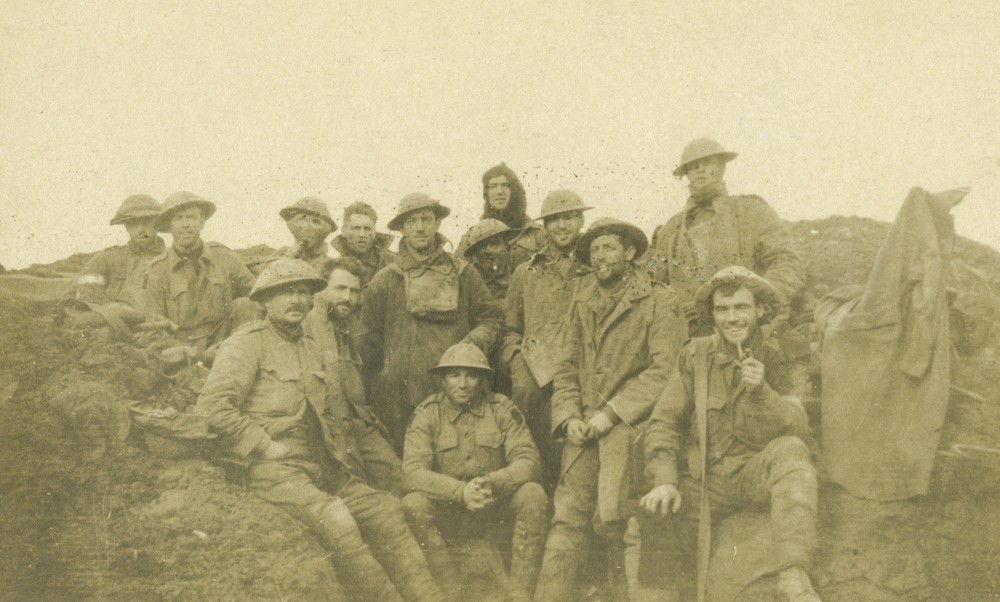
Photograph M 767/11. Mallyon's stretcher bearer comrades. M 767 Herbert Thomas Moffitt Mallyon Papers, John Oxley Library, State Library of Queensland.
As he recorded the relentless routine of going into the trenches, enduring several days under fire, then retiring to billets behind the lines, Herbert revealed himself as a capable young man with a dry wit, an admirable work ethic, and an obvious affection for his comrades-in-arms. Leave was anticipated with enthusiasm and relief, and resumption of duties with resigned pragmatism.
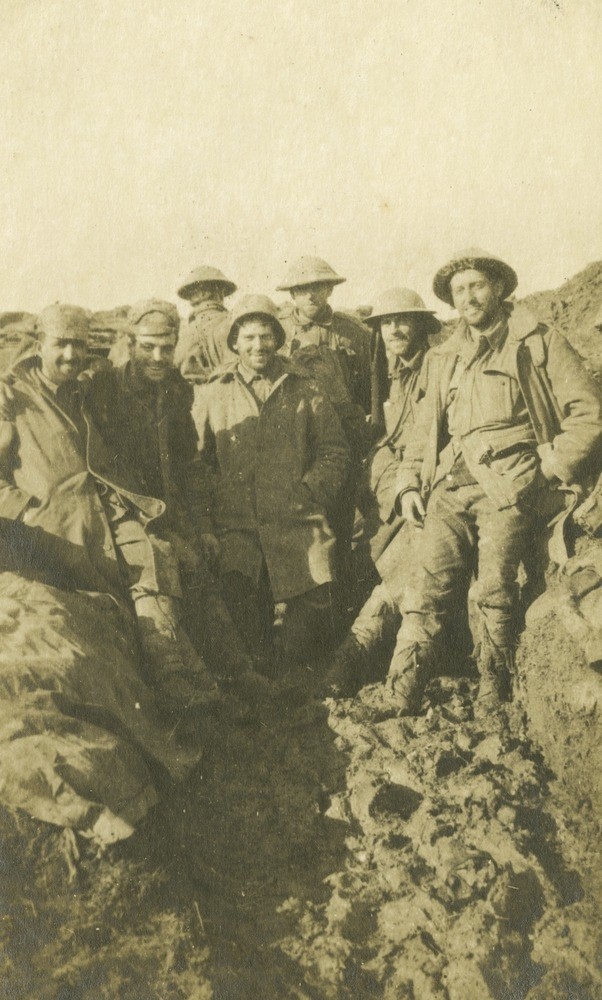
Photograph M 767/11. Mallyon's field ambulance comrades in a muddy trench, France. M 767 Herbert Thomas Moffitt Mallyon Papers, John Oxley Library, State Library of Queensland.
Herbert never made it home to Queensland. His later diary entries noted increasing casualties among the members of the Field Ambulance, particularly the stretcher bearers, and on 29th September 1917 Herbert too was wounded in action, evacuated, and died of multiple shell wounds.
His grieving family submitted a death notice to The Capricornian newspaper:
MALLYON. —Died of wounds in France, September 29, 1917, Private H. T. M. Mallyon, second son of Mr. and Mrs. T. E. Mallyon, "Dalwood," Springsure.
Not one of us was by his side
To watch his last faint sighs,
Or whisper just one loving word
Before he closed his eyes.
We never knew the pain he bore,
We never saw him die;
We only knew he passed away,
But hope to meet on high.
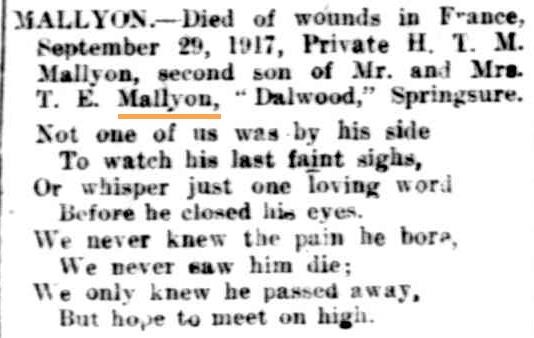
Death notice in The Capricornian, 3 November 1917
In a heartfelt letter to Herbert’s mother Mrs Mallyon, the members of 15th Australian Field Ambulance expressed their deep sorrow that their comrade Mallyon had been killed. Every member of C Section signed their name:
France
10th January 1918
Dear Mrs Mallyon
We are all very sorry that circumstances have prevented us sending before this, a joint letter expressing our deep sorrow at the loss of our much loved comrade Herb. Most of us were evacuated soon after his death through wounds or gas to hospital, & thus separated we could only await the return of at least some of those who knew & admired your son, since he landed in Egypt. Each one of us looked upon him as a tower of strength during the whole of his active service, & it is not surprising that his loss is so deeply felt among us. In Egypt & in France, he had ever proved himself a true comrade & loyal friend to all who were fortunate enough to be associated with him. We miss him more than we can express, after two years of close comradeship. We cannot even attempt to measure the loss felt by you, his Mother, but can only, in our poor way, offer our heartfelt sympathy in your sad bereavement. He met his death while stretcher-bearing on the Ypres front. He, & his squad, were returning from a carry, when a piece of bursting shell struck him. There is a slight consolation in knowing that he died instantly, without suffering any pain. We carried him back to the well kept cemetery at Ypres, & with a Church of England padre officiating made our last farewells to the one who, above many others, had, in life & death, earned our love & admiration. A nice large cross is erected on his grave to mark his last resting place, & arrangements are made by the Military Authorities to have all these graves kept in good order, & will continue to do so after the War, we believe.
We are,
Yours very sincerely,
72 Pte L. Jessays G.H. Wills 6044
8789 Pte P.E. Welleahow Pte A.E .Jackson 6072
Pte A. Goulden 13292 7756 Pte J. Kingsley
Pte H. Page 1579 8473 Pte H Shean
Sgt A. H. Inder 8480 W.L. Thornton
Pte K. Corient 13434 4305 A J Carlisle
Pte E.L. Allen 6056 8855 A E. Powell.
8854 R.L. Windsor 8792 L/Cpl H. Ramsden
14864 S. Howells 7672 N.J. Collins
Clive Rondford 4019 9886 L.G. Chandler
9888 P.J. Horan 9891 L/Cpl L.H. Parker
C Section
15th Australian Field Ambulance
A.I.F.
Sgd: JH Parker. 9891
Private Herbert Mallyon is included in the Distant Lines: Queensland voices of the First World War exhibition currently on at State Library of Queensland until 15 November 2015. He is one of 25 Queenslanders whose experiences and collections are featured in the exhibition.
Robyn Hamilton – QANZAC100 Content Curator, State Library of Queensland
Comments
Your email address will not be published.
We welcome relevant, respectful comments.